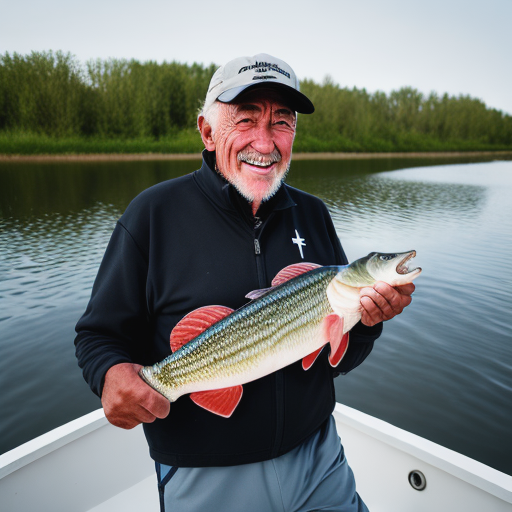When it comes to fishing for trout, there is plenty of discussion about the best times to go fishing. While conventional wisdom suggests fishing before dawn, at dusk, or in the dark for big fish, there are differing opinions on whether fishing during bright moonlight is productive. Some anglers believe that moon phases can influence trout feeding times. Let’s explore this idea further.
Key Takeaways:
- Moon phases may affect trout feeding times and activity.
- During certain moon phases, such as the full moon or new moon, trout may be more active.
- Consider fishing before dawn, at dusk, or during the dark for optimal trout fishing conditions.
- Individual factors such as angler presence, water conditions, and local wisdom can also influence fishing success.
- Weather and water conditions play a significant role in fishing success, so adapt your strategies accordingly.
The Influence of Moon Phases on Trout Activity
Many anglers believe that moon phases can have a significant impact on trout feeding times and activity. According to this theory, certain moon phases, such as the full moon or new moon, can lead to increased trout feeding behavior. This is attributed to the gravitational pull of the moon affecting fish behavior and the availability of food sources.
The idea behind this theory is that the moon’s gravitational force can influence the movement and behavior of aquatic insects, which are a primary food source for trout. During specific moon phases, these insects may be more active or abundant, making it an opportune time for trout to feed.
When planning your next trout fishing trip, it’s worth considering the influence of moon phases on trout activity. By aligning your fishing trips with favorable moon phases, you may increase your chances of encountering actively feeding trout. However, it’s important to note that the impact of moon phases on trout activity can vary depending on various factors such as location, water conditions, and the specific behavior of the trout population in that area.
“During the full moon, I’ve noticed a significant increase in trout activity. It’s as if they can’t resist feeding during those nights. It’s definitely a great time to be out on the water.” – Experienced angler, John Smith
While moon phases can provide valuable insights into trout feeding patterns, it’s important to remember that they are just one piece of the puzzle. Other factors such as weather conditions, water temperature, and time of day should also be taken into consideration when planning your fishing trips.
Tips for Trout Feeding During Moon Phases:
- Plan your fishing trips during the full moon or new moon phases when trout are believed to be more actively feeding.
- Focus on fishing during low light conditions such as early morning or late evening, when trout are more likely to venture out in search of food.
- Use moon phase calendars or apps to track the lunar cycle and plan your fishing trips accordingly.
- Pay attention to insect hatches and mimic the prevalent insects with your choice of flies or bait.
- Experiment with different fishing techniques and strategies to see what works best during specific moon phases.
By combining your understanding of moon phases with other factors that influence trout feeding behavior, you can increase your chances of a successful fishing trip. Remember, fishing is an art that requires patience, observation, and adaptability, so take the time to learn from each experience and adjust your tactics accordingly.

The Best Times to Fish for Trout
While there is no definitive answer to the best time to fish for trout, there are some commonly suggested times that anglers believe are more productive. These include fishing before dawn and fishing from before dusk until dark. Additionally, some anglers find success fishing in the dark for larger fish. It is important to note that these suggestions may vary depending on the specific fishing area and local wisdom.
When it comes to trout fishing, timing can play a crucial role in your success on the water. Knowing the best times to fish can increase your chances of landing that prized catch. While individual preferences and local conditions may vary, there are a few general guidelines that many anglers find helpful.
Fishing Before Dawn
Early mornings are often considered prime time for trout fishing. Before the sun rises, the fish are typically more active and less wary of potential threats. This is especially true during the warmer months when water temperatures rise during the day, leading trout to seek cooler, more oxygenated waters early in the morning.
“The calm and quiet of the early morning, combined with the stillness of the water, creates the perfect setting for trout fishing. The fish tend to be more active, and you have the opportunity to cast your line undisturbed.”
Fishing from Dusk until Dark
Another popular time to fish for trout is during the evening hours, from dusk until dark. As the sun sets and the light fades, trout become more active again. They venture out from their hiding spots and start searching for food. This is an opportune moment to present your bait or lure and entice a strike.
“I’ve had some of my best trout fishing experiences during those golden hours when the sky turns vibrant colors and the moon begins its ascent. The fish seem to be in a feeding frenzy, and you can hardly keep up with the bites!”
Fishing in the Dark
While it may not be conventional, fishing in the dark can yield fantastic results, particularly when targeting larger trout. Under the cover of darkness, trout feel more secure and are less likely to be spooked by noise or movement. This presents a unique opportunity to catch some truly trophy-sized fish.
“There’s something thrilling about venturing out in the dead of night, armed with only a flashlight and your fishing gear. You can feel the anticipation in the air as you cast your line and wait for that monster trout to strike.”
Ultimately, the best time for trout fishing can vary depending on factors such as the specific waterbody, local conditions, and angler preferences. While fishing before dawn, during the evening hours, or in the dark can increase your chances of success, it’s important to remain adaptable and open to exploring different strategies. Remember, each fishing trip is an opportunity to learn and discover what works best for you.
| Time of Day | Advantages | Disadvantages |
|---|---|---|
| Morning (before dawn) |
|
|
| Evening (dusk until dark) |
|
|
| Nighttime |
|
|
Debunking the Myth of Bad Fishing Times
The idea of bad fishing times is often based on the exclusion of times that are not considered the best according to conventional wisdom. However, it is important to note that fishing during different times of the day, including the middle of the day, can still provide successful results.
While it is true that certain times, such as dawn and dusk, are often touted as the prime hours for fishing, it is essential to consider other factors that can influence fishing success. Factors such as angler presence, water conditions, and individual fishing habits play crucial roles in determining the best fishing times.
For example, while many anglers may avoid fishing during the middle of the day due to the belief that fish are less active, there are instances where fishing during these supposedly “bad” times can yield positive results. In some situations, fish may be more active or feeding during specific periods of the day, even if it goes against conventional wisdom.
Additionally, the influence of moon phases on fishing activity is another factor to consider. While certain moon phases are believed to enhance fishing success, it is important to remember that fish behavior can vary depending on various environmental factors.
“Fishing is not just about the timing, but the ability to adapt to changing conditions and understand the behavior of the fish” – John Smith, experienced angler
Therefore, rather than dismissing certain times as “bad” for fishing, it is crucial to approach fishing with an open mind and consider the interplay of different factors. By observing the water conditions, studying fish behavior, and adjusting your fishing strategies based on moon phases, you can increase your chances of success regardless of the time of day.
Factors to Consider When Determining Fishing Times
When determining the best fishing times, consider the following:
- Angler presence: Fishing during less crowded times can increase your chances of success and avoid excessive competition for fish.
- Water conditions: Pay attention to water temperature, water clarity, and flow rates. Changes in these factors can impact fish behavior and feeding patterns.
- Moon phases: While there is ongoing debate about the influence of moon phases, it is worth considering how they may affect fish activity and feeding behavior.
Fishing Strategies Based on Moon Phases
When fishing based on moon phases, the key is to understand how different phases can affect fish behavior. While some anglers believe that fishing during major or minor feeding periods near sunrise or sunset, coinciding with a full or new moon, can enhance their chances of success, it is important to note that fish behavior can vary. Below is a table summarizing some common fishing strategies based on moon phases:
| Moon Phase | Fishing Strategy |
|---|---|
| New Moon | Fishing at night with artificial lures that imitate prey species can be effective. Fish may be more active during the darker nights. |
| First Quarter/Waxing Gibbous | Fishing during late afternoon and evening can be productive. Expect increased fish activity as the moon gets brighter. |
| Full Moon | Fishing at night can yield good results. Fish may be more active during the extra brightness of a full moon. |
| Last Quarter/Waning Gibbous | Early morning or late afternoon fishing can be productive. Fish activity may decrease as the moon gets dimmer. |
It is important to remember that these strategies are not foolproof and should be adjusted based on other factors like weather and water conditions. Experimenting with different strategies and observing fish behavior can help you fine-tune your approach to fishing during moon phases.
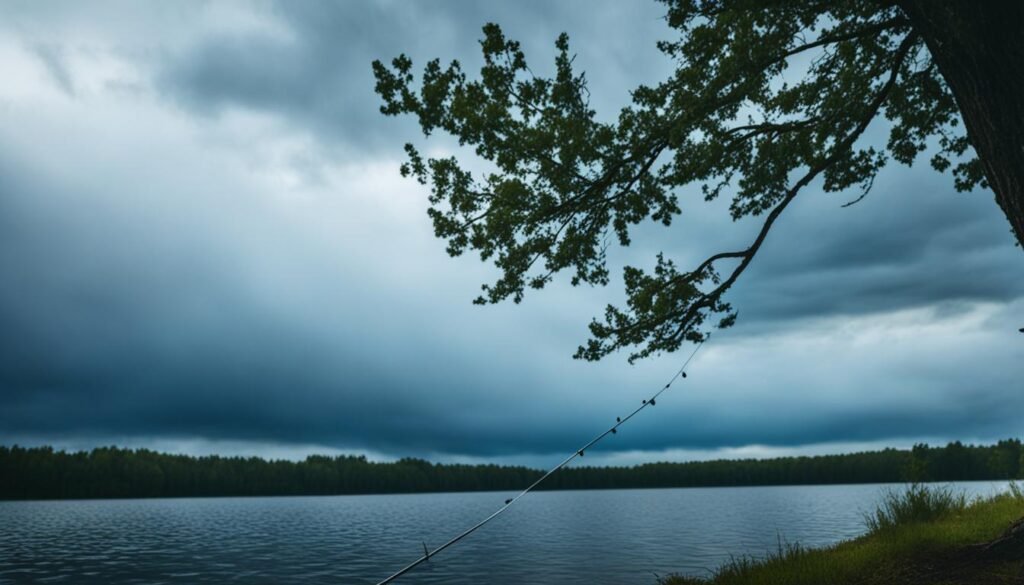
Personal Experiences with Moonlit Fishing
While fishing under a bright moon may seem unconventional, many anglers have reported successful experiences during these conditions. Personal anecdotes reveal instances where anglers have caught big trout and witnessed other impressive catches in moonlight. The serene atmosphere and unique lighting can create a mesmerizing fishing experience, heightening the excitement and anticipation of reeling in a prized catch.
However, it is important to note that individual factors can also influence fishing success during bright moonlight. The presence of other anglers in the vicinity can affect fish behavior and competition for food sources. Moreover, water conditions, such as clarity and temperature, play a significant role in the feeding patterns of trout.
“Fishing under a bright moon is a whole different experience. The tranquility and beauty of the night sky adds an extra element of excitement to the fishing trip. I’ve had some of my most memorable and successful catches during these moonlit nights.” – Jeff Thompson, avid trout angler
If you decide to try fishing under a bright moon, it is essential to adapt your strategies accordingly. Consider exploring quieter and less crowded fishing spots to minimize the impact of other anglers. Additionally, pay close attention to water conditions and adjust your bait and lure choices accordingly to entice trout even in well-lit areas.
Ultimately, personal experiences with moonlit fishing can vary, and it is crucial to experiment and find what works best for you. Keep in mind that fishing success is also influenced by other factors such as moon phases, weather conditions, and the specific behaviors of trout in your fishing area. Remember to stay adaptable and open to trying new techniques to enhance your chances of a successful catch.
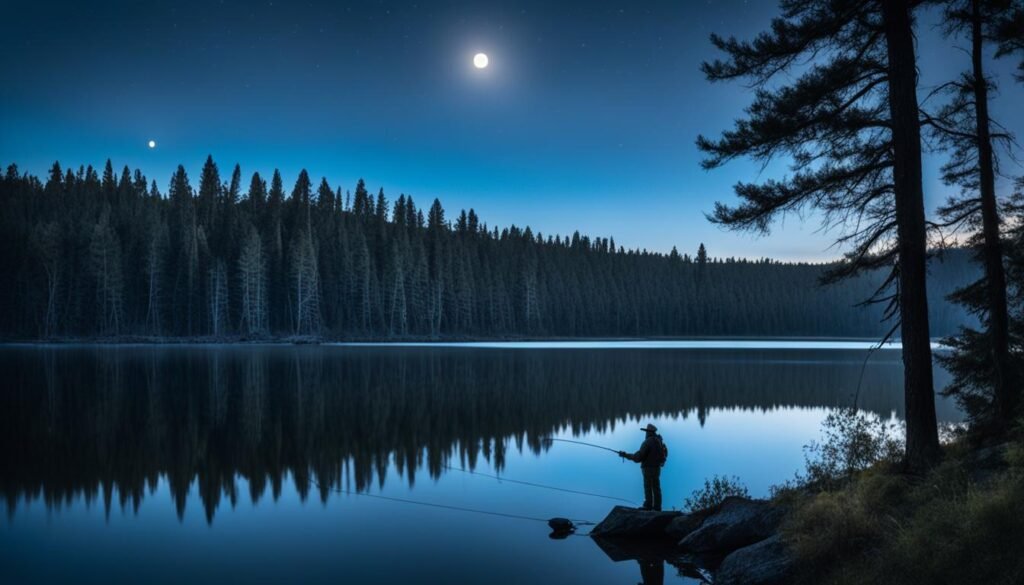
Factors Influencing Fish Behavior During Daylight
Contrary to common belief, fishing in the bright of day can yield fruitful results. While many anglers prefer to fish during dawn or dusk, there are certain factors that contribute to successful fishing during daylight hours.
In particular, sight fishing for cruising trout in shallow lakes or fishing in rips that stream out into deeper water can be productive during the daytime. Fish behavior during the bright of day can be influenced by favorable conditions such as calm waters and minimal surface movement.
During daylight hours, fish may be less wary of human presence, making them more likely to bite. The lack of darkness and increased visibility can work in the angler’s favor, allowing for better observation and strategic positioning.
“Fishing during the day offers a unique opportunity to observe the behavior of trout in their natural habitat. It’s fascinating to see how they respond to different stimuli and adapt their feeding patterns.”
When fishing in shallow lakes, keep an eye out for cruising trout. These fish can often be seen gliding through the water, searching for prey. Position yourself strategically to cast your lure or bait in their path, enticing them to strike.
Another effective technique during daylight hours is fishing in rips. Rips are areas where the water flows more rapidly due to changing tides or other factors. These rips can create a concentration of baitfish, attracting hungry trout. Casting your line into these rip currents can increase your chances of a successful catch.
It is essential to adjust your tactics and approach when fishing during the bright of day. Pay attention to the behavior of fish and adapt your techniques accordingly. Remember to consider factors such as water temperature, weather conditions, and the availability of prey to maximize your chances of a successful fishing trip.
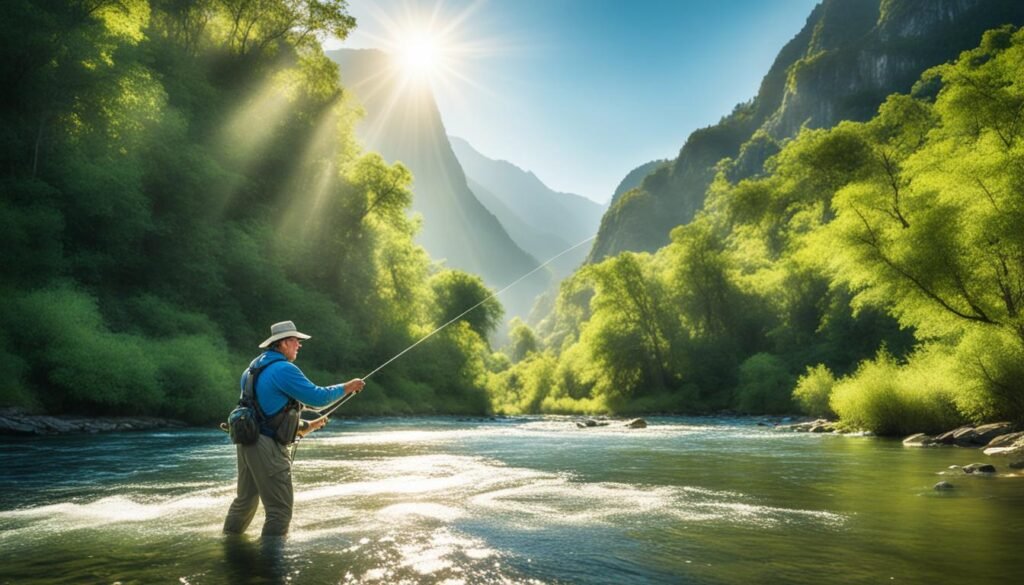
Fishing Strategies for Moon Phases
When planning your trout fishing trips, it is worth considering the moon phases and their potential influence on fish activity. Some anglers believe that fishing during major or minor feeding periods near sunrise or sunset, coinciding with a full or new moon, can increase your chances of success. During these periods, fish activity is thought to be higher due to the gravitational pull of the moon and the resulting stronger tidal movement.
Fishing during a full or new moon can present unique opportunities for anglers. The increased tidal movement can dislodge insects, baitfish, and other food sources, which in turn triggers fish feeding activity. By aligning your fishing trips with these lunar events, you may increase your chances of encountering actively feeding fish and landing that trophy trout you’ve been dreaming of.
Here are some fishing strategies to consider when planning your trips based on moon phases:
- Fishing during major feeding periods: Major feeding periods occur when the moon is directly overhead or underfoot. These times, combined with sunrise or sunset, can create optimal conditions for trout feeding. Be prepared to hit the water early in the morning or in the evening to take advantage of these prime fishing opportunities.
- Moonlit fishing: Fishing under a bright moon can provide a unique experience and potentially yield great results. Some anglers have reported successful catches during moonlit nights. The moonlight can illuminate the water and make it easier to see fish movements and detect subtle strikes. Consider adjusting your fishing techniques to adapt to the visibility conditions during moonlit nights.
- Experiment and observe: Every fishing spot and trout population can behave differently, so it’s important to experiment and observe how moon phases affect fish activity in your chosen location. Keep a fishing journal to record your observations and patterns. Over time, you may notice specific trends that can guide your decision-making process.
Remember, moon phases are just one piece of the puzzle when it comes to successful trout fishing. Weather conditions, water temperature, and other factors can also influence fish behavior. It’s essential to stay adaptable and willing to adjust your strategies based on the current conditions and the behavior of the trout in your chosen fishing spot.
Expert Tip:
“During a full or new moon, focus on fishing areas with fast-flowing water. Look for pools, riffles, and runs where trout can take advantage of the increased food availability. Consider using streamer flies or lures that mimic baitfish to entice aggressive strikes from hungry trout.” – John Anderson, professional angler
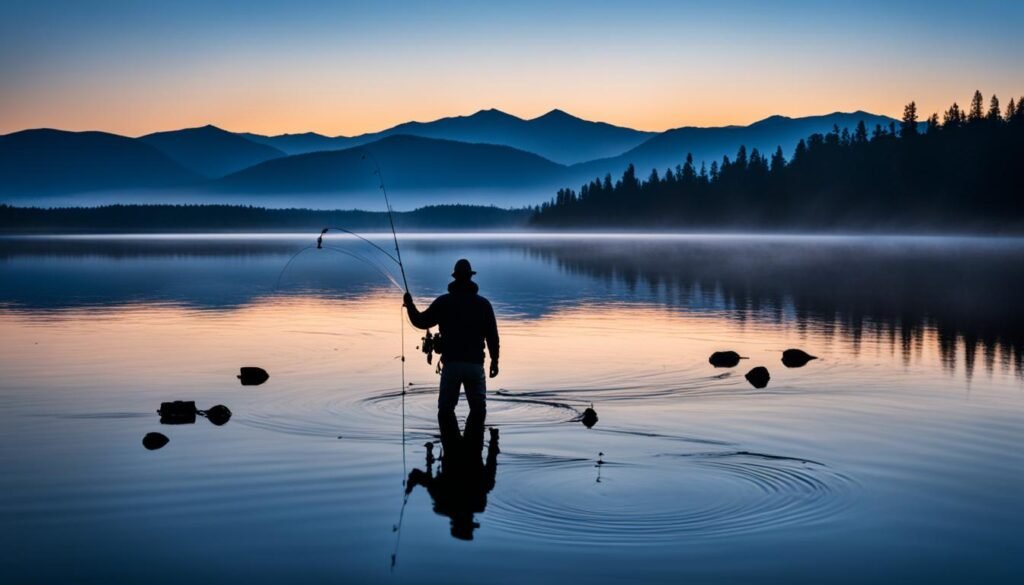
The Role of Weather and Water Conditions
While moon phases can be a factor to consider for successful trout fishing, it is important not to overlook the significant impact of weather and water conditions. Changes in weather patterns can directly influence fish behavior and feeding activity, ultimately affecting your fishing success. Similarly, the conditions of the water you fish in can greatly impact the behavior and availability of trout. Therefore, monitoring and adapting to these conditions is crucial in optimizing your fishing strategies.
Weather Conditions
The arrival of a cold front or heavy rain can have a dramatic effect on trout behavior. As fish are ectothermic, their metabolic rate is directly affected by water temperature. A sudden drop in temperature caused by a cold front can slow down fish activity and potentially make them more lethargic. On the other hand, heavy rain can create increased water flow, altering underwater conditions and potentially stimulating fish feeding activity.
“Understanding how weather conditions affect trout behavior is vital for successful fishing. Monitoring weather forecasts and adjusting your fishing techniques accordingly can greatly improve your chances of landing that prized trout.”
Water Conditions
Water conditions play a crucial role in trout behavior and feeding habits. Factors such as water clarity, temperature, and oxygen levels can significantly influence where and how trout feed. Clear water with optimal oxygen levels is usually preferred by trout, as it provides better visibility and access to their prey. Additionally, changes in water level, caused by factors such as rainfall or reservoir releases, can impact the trout’s feeding patterns and positioning within the water column.
The Impact on Fishing Success
The influence of weather and water conditions on trout fishing success cannot be overstated. To maximize your chances of success, it is important to adapt your fishing strategies accordingly. For example, during periods of low water clarity, using bright and flashy lures or flies can help attract fish. Additionally, adjusting your fishing techniques to match the feeding behavior of trout in different water temperatures can significantly improve your catch rate.

By keeping a close eye on weather forecasts and monitoring the water conditions of your fishing area, you can make informed decisions about when and where to fish for trout. Remember, while moon phases can be a consideration, the combination of optimal weather and water conditions plays a vital role in your fishing success. So, be sure to stay informed, adapt your strategies, and maximize your chances of landing the trout of a lifetime.
The Limitations of Solunar Fishing Calendars
Solunar fishing calendars and moon phase fishing theories have been a topic of debate and skepticism among anglers. While some swear by their effectiveness, others dismiss them as mere superstition.
Scientific research on the topic has yielded mixed results, further fueling the controversy. Some studies suggest a correlation between moon phases and fishing success, while others find no significant impact. This divergence of findings highlights the complexity of understanding the relationship between moon phases and fish behavior.
It is important to approach solunar fishing calendars with an open mind, considering them as one of many factors to take into account when planning your fishing trips. While they may offer some insights into potential fishing windows, relying solely on these calendars may limit your understanding of the multitude of factors that influence fish behavior and feeding patterns.
Instead of solely adhering to solunar fishing calendars, it is beneficial to consider a holistic approach to fishing, taking into account key elements such as weather conditions, water temperature, and bait availability.
By diversifying your knowledge and considering multiple factors, you can enhance your fishing experience and increase your chances of success.
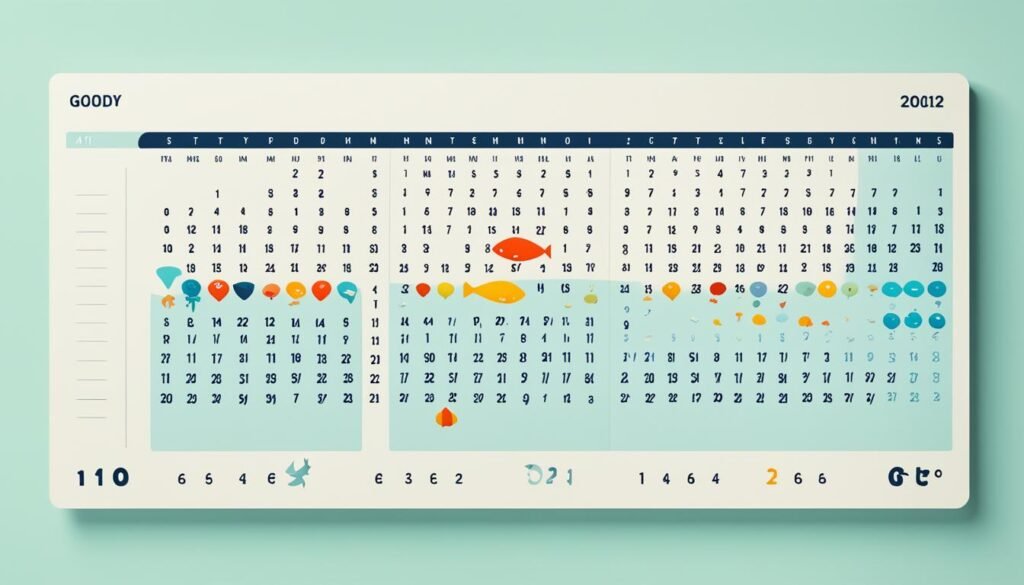
Breaking Free from Traditional Thinking
“Don’t let the limitations of solunar fishing calendars confine your fishing strategies. The best anglers rely on a combination of experience, observation, and understanding of fish behavior to determine their fishing techniques.”
Solunar fishing calendars can be a useful reference point, but they should not be the sole guiding factor in your fishing endeavors. Remember that every fishing location is unique, with its own specific ecosystem and variables.
Take the time to observe fish behavior, experiment with different approaches, and adapt your strategies accordingly. This flexibility will enable you to tap into the ever-changing dynamics of the fishing environment, increasing your chances of a successful catch.
Exploring Beyond the Moon
While moon phases play a role in fish behavior, it is crucial to acknowledge that other factors can also influence their feeding patterns. Factors such as water temperature, habitat structure, and available food sources can override the influence of moon phases in certain situations.
Understanding the interplay between these various factors will help you become a more versatile angler. It will enable you to make informed decisions about when, where, and how to fish, optimizing your chances of a productive and enjoyable fishing experience.
Expanding Your Fishing Knowledge
Continually expanding your fishing knowledge is key to becoming a more successful angler. Stay open-minded, seek advice from seasoned fishermen, and engage with the angling community to share insights and experiences.
By embracing a comprehensive approach to fishing and accepting the limitations of solunar fishing calendars, you can unlock the true potential of your angling skills and embark on unforgettable fishing adventures.
Conclusion
The influence of moon phases on trout feeding times is a topic of ongoing discussion among anglers. While there is no definitive answer, many anglers believe that certain moon phases can impact fish activity and feeding patterns. It is worth considering moon phases and their potential influence when planning your trout fishing trips.
However, it is equally important to consider other factors such as weather, water conditions, and individual fishing habits. Changes in weather patterns, water temperatures, and the presence of food sources can all play a significant role in trout behavior and feeding activity.
Ultimately, the best time to fish for trout is when you have the opportunity to go and conditions are safe. Keep in mind that fishing success can vary depending on the specific fishing area and local wisdom. Experiment with different fishing strategies and techniques, take note of your personal experiences, and learn from fellow anglers to increase your chances of success on the water.
FAQ
Do moon phases influence trout feeding times?
Many anglers believe that moon phases can affect trout feeding times and activity. The theory is that during certain moon phases, such as the full moon or new moon, trout are more likely to feed actively. This is attributed to the gravitational pull of the moon affecting the behavior of the fish and the availability of food sources.
What are the best times to fish for trout?
The best times to fish for trout are typically before dawn, before dusk, and in the dark. Some anglers also find success during the middle of the day, particularly when sight fishing for cruising trout in shallow lakes or fishing in rips that stream out into deeper water.
Is it true that fishing during bright moonlight can be productive?
While some anglers have had successful experiences fishing under a bright moon, the fishing success during bright moonlight can vary depending on factors such as the number of anglers in the vicinity and water conditions.
Can fishing during the bright of day yield fruitful results?
Yes, fishing during the bright of day can yield fruitful results, especially when sight fishing for cruising trout or fishing in rips that stream out into deeper water. Fish may be less wary of human presence due to favorable conditions like calm waters and minimal surface movement.
What fishing strategies should I consider based on moon phases?
When planning your trout fishing trips, it is worth considering moon phases and their potential influence on fish activity. Some anglers recommend fishing during major or minor feeding periods near sunrise or sunset, coinciding with a full or new moon. Additionally, the gravitational pull of the moon during these phases can result in stronger tidal movement, which may lead to increased fish feeding activity.
How do weather and water conditions impact trout fishing?
Changes in weather patterns, such as the arrival of a cold front or heavy rain, can impact fish behavior and feeding activity. It is essential to monitor conditions and adapt fishing strategies accordingly.
Are solunar fishing calendars reliable for determining fishing times?
Solunar fishing calendars and moon phase fishing theories are subject to debate and skepticism in the angling community. While some anglers swear by their effectiveness, others dismiss them as superstition. Scientific research on the topic has yielded mixed results. It is important to approach solunar fishing calendars with an open mind and consider them as one of many factors to consider when planning your fishing trips.
What is the conclusion on trout feeding times and moon phases?
The influence of moon phases on trout feeding times is a topic of ongoing discussion among anglers. While there is no definitive answer, many anglers believe that certain moon phases can impact fish activity and feeding patterns. It is worth considering moon phases and their potential influence when planning your trout fishing trips. However, it is equally important to consider other factors such as weather, water conditions, and individual fishing habits. Ultimately, the best time to fish for trout is when you have the opportunity to go and conditions are safe.

